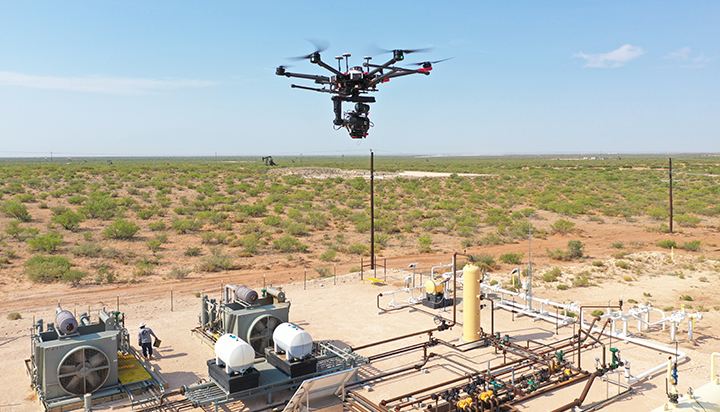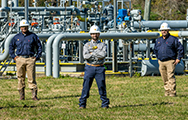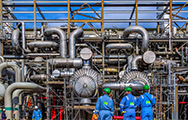Methane emissions
Methane is a potent greenhouse gas (GHG) and when it is released into the atmosphere it has a much higher immediate global warming impact than carbon dioxide.
We use a range of methods and technologies to limit leaks of methane from our oil and gas operations, including implementing leak detection and repair programmes. We use the best available technologies such as drones and other aircraft equipped with optical gas imaging cameras, and satellites to detect leaks.

We are expanding our use of drones for methane leak detection at our sites in the Permian Basin, USA.
In 2020, in the Permian Basin, USA, where we have more than 400 sites, we deployed drones with specialised cameras and laser detection technology to detect methane emissions. This enables us to repair leaks and reduce emissions faster and more efficiently by reducing the time inspection teams need to spend at sites. Read more about this project at www.shell.us/media/2020-media-releases/expanding-use-of-drones-for-methane-detection
At our Shell ONEGas facilities in the North Sea, we have reduced methane emissions by 55% (around 2,000 tonnes) since 2017 through a series of improvements to reduce gas venting, including minimising valve leakage.
Methane initiatives and collaborations
We encourage industry-wide action on methane emissions reduction by participating in voluntary initiatives. In 2020 we:
- were a founding signatory to the Oil and Gas Methane Partnership 2.0, which is designed to enhance methane emissions reporting and transparency and encourage greater participation across the industry;
- proposed recommendations to the European Commission on reducing methane emissions in the oil and gas industry, alongside BP, the Environmental Defense Fund, Eni, Equinor, the Florence School of Regulation, Repsol, the Rocky Mountain Institute, Total and Wintershall Dea; and
- advocated a return to the direct regulation of methane under the Clean Air Act in the USA.
We also participate in the Methane Guiding Principles coalition, which we initiated in 2017. The partnership’s growing membership includes major international and national oil companies and associate signatories such as the International Energy Agency and the UN Environment Programme.
Methane emissions performance
Our target is to maintain methane emissions intensity below 0.2% by 2025. This target covers all Upstream and Integrated Gas oil and gas assets for which Shell is the operator. In 2020, our methane intensity averaged 0.06% for assets with marketed gas and 0.01% for assets without marketed gas. Shell’s methane emissions intensity in 2020 ranged from below 0.01% to 0.6%.
Methane (CH4) emissions
thousand tonnes
Methane emissions by source in 2020
percentage
In 2020, our total methane emissions were 67 thousand tonnes compared with 91 thousand tonnes in 2019, in part driven by divestments (for example, in Canada and the USA) and decreased flaring. Methane emissions were less than 5% of Shell’s GHG emissions on a CO2-equivalent basis. More than 60% of our reported methane emissions in 2020 came from flaring and venting in our upstream and midstream (for example, storage and processing) operations.




